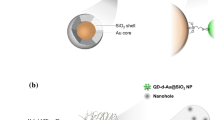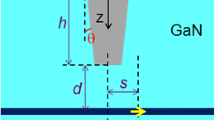Abstract
The electric field and radiated power of a radiating dipole located inside a spherical nano-cavity are formulated to show that the nano-cavity structure or nanoscale-cavity effect can enhance the near-field intensity inside the cavity and the far-field radiated power of the dipole. Such enhancements are caused by two contributing factors, including the classical electromagnetic scattering as formulated and the Purcell effect, which is implemented through a numerical feedback process by assuming a two-level system for the radiating dipole. The enhancement of near-field intensity results in the efficiency increase of Förster resonance energy transfer when both energy donor and acceptor are located inside the nano-cavity. By combining the enhancements of the field intensity of the donor and the radiated power of the acceptor, the color conversion efficiency can be increased through the nanoscale-cavity effect. We also numerically demonstrate that the nanoscale-cavity effect can enhance surface plasmon coupling for increasing the radiated power of a dipole located nearby an Ag nanoparticle inside a nano-cavity.










Similar content being viewed by others
Data Availability
All data included in this paper are available upon request by contacting with the corresponding author.
References
Purcell EM (1946) Spontaneous emission probabilities at radio frequencies. Phys Rev 69:681–681
Chen D, Xiao H, Han J (2012) Nanopores in GaN by electrochemical anodization in hydrofluoric acid formation and mechanism. J Appl Phys 112(6):064303
Griffin PH, Oliver RA (2020) Porous nitride semiconductors reviewed. J Phys D: Appl Phys 53(38):383002
Schwab MJ, Chen D, Han J, Pfefferle LD (2013) Aligned mesopore arrays in GaN by anodic etching and photoelectrochemical surface etching. J Phys Chem C 117(33):16890–16895
Schwab MJ, Han J, Pfefferle LD (2015) Neutral anodic etching of GaN for vertical or crystallographic alignment. Appl Phys Lett 106(24):241603
Tseng WJ, van Dorp DH, Lieten RR, Vereecken PM, Borghs G (2014) Anodic etching of n-GaN epilayer into porous GaN and its photoelectrochemical properties. J Phys Chem C 118(51):29492–29498
Chen CH, Kuo SY, Feng HY, Li ZH, Yang S, Wu SH, Hsieh HY, Lin YS, Lee YC, Chen WC, Wu PH, Chen JC, Huang YY, Lu YJ, Kuo Y, Lin CF, Yang CC (2023) Photon color conversion enhancement of colloidal quantum dots inserted into a subsurface laterally-extended GaN nano-porous structure in an InGaN/GaN quantum-well template. Opt Express 31(4):6327–6341
Yang S, Feng HY, Lin YS, Chen WC, Kuo Y, Yang CC (2023) Effects of surface plasmon coupling on the color conversion from an InGaN/GaN quantum-well structure into colloidal quantum dots inserted into a nearby porous structure. Nanomaterials 13(2):328
Chanyawadee S, Lagoudakis PG, Harley RT, Charlton MDB, Talapin DV, Huang HW, Lin CH (2010) Increased color-conversion efficiency in hybrid light-emitting diodes utilizing non-radiative energy transfer. Adv Mater 22(5):602–606
Krishman C, Brossard M, Lee KY, Huang JK, Lin CH, Kuo HC, Charlton MDB, Lagoudakis PG (2016) Hybrid photonic crystal light-emitting diode renders 123% color conversion effective quantum yield. Optica 3(5):503–509
Zhuang Z, Guo X, Liu B, Hu F, Li Y, Tao T, Dai J, Zhi T, Xie Z, Chen P, Chen D, Ge H, Wang X, Xiao M, Shi Y, Zheng Y, Zhang R (2016) High color rendering index hybrid III-nitride/nanocrystals white light-emitting diodes. Adv Funct Mater 26(1):36–43
Athanasiou M, Papagiorgis P, Manoli A, Bernasconi C, Poyiatzis N, Coulon PM, Shields P, Bodnarchuk MI, Kovalenko MV, Wang T, Itskos G (2020) InGaN nanohole arrays coated by lead halide perovskite nanocrystals for solid-state lighting. ACS Appl Nano Mater 3(3):2167–2175
Wan R, Li G, Gao X, Liu Z, Li J, Yi X, Chi N, Wang L (2021) Nanohole array structured GaN-based white LEDs with improved modulation bandwidth via plasmon resonance and non-radiative energy transfer. Photon Res 9(7):1213–1217
Du Z, Li D, Guo W, Xiong F, Tang P, Zhou X, Zhang Y, Guo T, Yan Q, Sun J (2021) Quantum dot color conversion efficiency enhancement in micro-light-emitting diodes by non-radiative energy transfer. IEEE Electron Dev Lett 42(8):1184–1187
Huang YY, Li ZH, Lai YC, Chen JC, Wu SH, Yang S, Kuo Y, Yang CC, Hsu TC, Lee CL (2022) Nanoscale-cavity enhancement of color conversion with colloidal quantum dots embedded in the surface nano-holes of a blue-emitting light-emitting diode. Opt Express 30(17):31322–31335
Förster T (1946) Energy transport and fluorescence. Naturwissenschaften 33:166–175
Demira HV, Nizamoglub S, Erdemb T, Mutluguna E, Gaponikc N, Eychmuller A (2011) Quantum dot integrated LEDs using photonic and excitonic color conversion. Nano Today 6(6):632–647
Zhang F, Liu J, You G, Zhang C, Mohney SE, Park MJ, Kwak JS, Wang Y, Koleske DD, Xu J (2012) Nonradiative energy transfer between colloidal quantum dot-phosphors and nanopillar nitride LEDs. Opt Express 20(S2):A333–A339
Ni CC, Kuo SY, Li ZH, Wu SH, Wu RN, Chen CY, Yang CC (2021) Förster resonance energy transfer in surface plasmon coupled color conversion processes of colloidal quantum dots. Opt Express 29(3):4067–4081
Chen YP, Ni CC, Wu RN, Kuo SY, Su YC, Huang YY, Chen JW, Hsu YC, Wu SH, Chen CY, Wu PH, Kiang YW, Yang CC (2021) Combined effects of surface plasmon coupling and Förster resonance energy transfer on the light color conversion behaviors of colloidal quantum dots on an InGaN/GaN quantum-well nanodisk structure. Nanotechnology 32(13):135206
Yang S, Lai YC, Feng HY, Lee YC, Li ZH, Wu SH, Lin YS, Hsieh HY, Chu CJ, Chen WC, Kuo Y, Yang CC (2023) Enhanced color conversion of quantum dots located in the hot spot of surface plasmon coupling. IEEE Photon Technol Lett 35(5):273–276
Kuo Y, Ting SY, Liao CH, Huang JJ, Chen CY, Hsieh C, Lu YC, Chen CY, Shen KC, Lu CF, Yeh DM, Wang JY, Chuang WH, Kiang YW, Yang CC (2011) Surface plasmon coupling with radiating dipole for enhancing the emission efficiency of a light-emitting diode. Opt Express 19(14):A914–A929
Kuo Y, Chang WY, Lin CH, Yang CC, Kiang YW (2015) Evaluating the blue-shift behaviors of the surface plasmon coupling of an embedded light emitter with a surface Ag nanoparticle by adding a dielectric interlayer or coating. Opt Express 23(24):30709–30720
Cai CJ, Wang YT, Ni CC, Wu RN, Chen CY, Kiang YW, Yang CC (2020) Emission behaviors of colloidal quantum dots linked onto synthesized metal nanoparticles. Nanotechnology 31(9):095201
Wang YT, Liu CW, Chen PY, Wu RN, Ni CC, Cai CJ, Kiang YW, Yang CC (2019) Color conversion efficiency enhancement of colloidal quantum dot through its linkage with synthesized metal nanoparticle on a blue light-emitting diode. Opt Lett 44(23):5691–5694
Chang WY, Kuo Y, Kiang YW, Yang CC (2019) Simulation study on light color conversion enhancement through surface plasmon coupling. Opt Express 27(12):A629–A642
Lin CH, Chiang HC, Wang YT, Yao YF, Chen CC, Tse WF, Wu RN, Chang WY, Kuo Y, Kiang YW, Yang CC (2018) Efficiency enhancement of light color conversion through surface plasmon coupling. Opt Express 26(18):23629–23640
Chen CY, Ni CC, Wu RN, Kuo SY, Li CH, Kiang YW, Yang CC (2021) Surface plasmon coupling effects on the Förster resonance energy transfer from quantum dot into rhodamine 6G. Nanotechnology 32(29):295202
Jin T, Uhlikova N, Xu Z, Zhu Y, Huang Y, Egap E, Lian T (2020) Competition of Dexter, Förster, and charge transfer pathways for quantum dot sensitized triplet generation. J Chem Phys 152(21):214702
Boyd RW (2008) Nonlinear Optics, 3rd edn. Academic press, pp 278–293
Loudon R (1991) The quantum theory of light, 2nd edn. Oxford university press, pp 78–79
Meystre P, Sargent M III (1999) Elements of quantum optics. Springer, p 344
Brus LE (1984) Electron-electron and electron-hole interactions in small semiconductor crystallites: The size dependence of the lowest excited electronic state. J Chem Phys 80(9):4403–4409
Kagan CR, Murray CB, Nirmal M, Bawendi MG (1995) Electronic energy transfer in CdSe quantum dot solids. Phys Rev Lett 76(9):1517–1520
Novotny L, Hecht B (2006) Principles of nano-optics. Cambridge University Press, pp 265–269 and 287
Kavokin AV, Baumberg JJ (2007) Weak-coupling microcavities. Chapter 6, Microcavities, 1st edn. Oxford University Press, pp 216–221
Jackson JD (1975) Classical Electrodynamics, 2nd edn. Wiley, p 395
Kuo Y, Lu YJ, Shih CY, Yang CC (2021) Simulation study on the enhancement of resonance energy transfer through surface plasmon coupling in a GaN porous structure. Opt Express 29(26):43182–43192
Kuo Y, Shih CY, Yang CC (2022) Simulation study of the effect of surface plasmon coupling on Förster resonance energy transfer behavior. Plasmonics 17(3):989–1000
Palik ED (1991) Handbook of optical constants of solids. Academic Press
Limonov MF, Rybin MV, Poddubny AN, Kivshar YS (2017) Fano resonances in photonics Nature photon 11(9):543–554
Funding
This research was funded by the Ministry of Science and Technology, Taiwan, the Republic of China, under the grant of MOST 111-2221-E-002-073 and MOST 110-2221-E-002-131.
Author information
Authors and Affiliations
Contributions
Yang Kuo: formulation and numerical algorithm preparation, numerical computations; C. C. (Chih-Chung) Yang: concept proposing, data interpretations, writing.
Corresponding author
Ethics declarations
Ethics Approval
This is a theoretical/numerical study on the nanoscale-cavity effects.
Consent to Participate
This is a theoretical/numerical study of the nanoscale-cavity effects on dipole emission, Förster resonance energy transfer, and surface plasmon coupling.
Consent for Publication
All authors of this paper agree to publish our theoretical/numerical research.
Conflict of Interest
The authors declare no competing interests.
Additional information
Publisher's Note
Springer Nature remains neutral with regard to jurisdictional claims in published maps and institutional affiliations.
Rights and permissions
Springer Nature or its licensor (e.g. a society or other partner) holds exclusive rights to this article under a publishing agreement with the author(s) or other rightsholder(s); author self-archiving of the accepted manuscript version of this article is solely governed by the terms of such publishing agreement and applicable law.
About this article
Cite this article
Kuo, Y., Yang, C.CC. Theoretical/Numerical Studies of the Nanoscale-Cavity Effects on Dipole Emission, Förster Resonance Energy Transfer, and Surface Plasmon Coupling. Plasmonics 19, 273–285 (2024). https://doi.org/10.1007/s11468-023-01991-x
Received:
Accepted:
Published:
Issue Date:
DOI: https://doi.org/10.1007/s11468-023-01991-x




